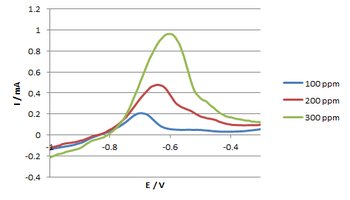VOLUME 7 NUMBER 2 (July to December 2014)

Philipp. Sci. Lett. 2014 7 (2) 372-375
available online: November 13, 2014
*Corresponding author
Email Address: benjtuason@gmail.com
Received: July 3, 2014
Revised: September 4, 2014
Accepted: September 5, 2014
SHORT COMMUNICATION
Determination of Cadmium (Cd2+) and Zinc (Zn2+) via Anodic Stripping Voltammetry with [Ru(NH3)6]3+/Nafion® Modified Electrodes
by Shirley Tiong Palisoc, Michelle Tiamzon Natividad, Patricia Denise DeVera, and Benjamin Simone B. Tuason*
Materials Science Laboratory, Physics Department,
De La Salle University, 2401 Taft Ave., Manila, Philippines
De La Salle University, 2401 Taft Ave., Manila, Philippines
Indium tin oxide (ITO) substrates were modified with [Ru(NH3)6]3+-doped Nafion® thin film using the drop-coating method. The redox mediator was successfully immobilized within the thin film. The modified electrodes were used to detect cadmium and zinc ions in de-ionized water via anodic stripping voltammetry (ASV). The effect of varying the concentration of the mediator [Ru(NH3)6]3+ on the signals from the heavy metal was also studied. Redox mediator concentration was varied to control the properties of the modified electrodes. Different concentrations of the heavy metal were tested using ASV. The conducting properties of ITO electrodes were enhanced with the deposition of Nafion® attaining minimal interference. The ASV tests yielded higher oxidation current peaks for the modified electrodes in contrast to unmodified electrodes. The oxidation peaks increased monotonically with the concentration of immobilized mediator.
© 2025 SciEnggJ
Philippine-American Academy of Science and Engineering